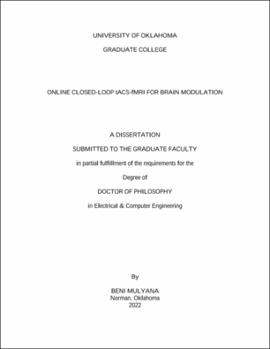| dc.description.abstract | Recent studies suggest that transcranial electrical stimulation (tES) can be performed during functional magnetic resonance imaging (fMRI). The novel approach of using concurrent tES-fMRI to modulate and measure targeted brain activity/connectivity may provide unique insights into the causal interactions between the brain's neural responses and psychiatric/neurologic signs and symptoms, and importantly, guide the development of new treatments. However, tES stimulation parameters to optimally influence the underlying brain activity may vary with respect to the phase difference, frequency, intensity, and electrode montage among individuals. The dissertation proposes a protocol for closed-loop tES-fMRI to optimize the frequency and phase difference of alternating current stimulation (tACS) for two nodes (frontal and parietal regions or called as frontoparietal regions) in individual participants. It is carefully considered the challenges in an online optimization of tES parameters with concurrent fMRI, specifically in its safety, artifact in fMRI image quality, online evaluation of the tES effect, and parameter optimization method, and the protocol is designed to run an effective study to enhance frontoparietal connectivity and working memory performance with the optimized tACS using closed-loop tES-fMRI. The dissertation provides technical details of the protocol, including electrode types, electrolytes, electrode montages, concurrent tES-fMRI hardware, online fMRI processing pipelines, and the optimization algorithm. Result analyses confirmed the implementation of this protocol worked successfully to improve frontoparietal connectivity compared to the control group. However, it did not give a significant difference in working memory improvement compared to the control group. Therefore, through literature study, in the future work Chapter, a better protocol is proposed to enhance the stimulation effect by including electrode montage and electric current optimization. | en_US |

